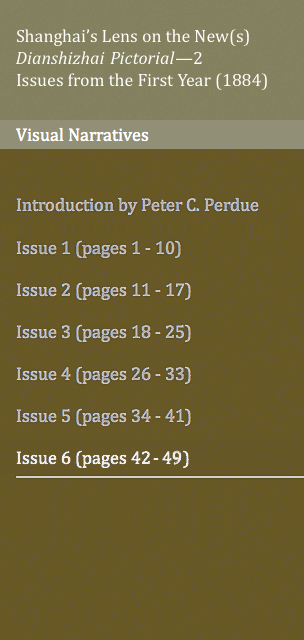| Images: Yale University Library, East Asia LibraryMassachusetts Institute of Technology © 2015 Visualizing Cultures |
 |
Title: “American Consul Arrives at Hankou” 美使抵漢 Year: 1884 Volume: 1 Issue: 6 Page Number: 42.2 (left) Caption Translation: American consul Yang arrived at Hankou in an American warship. Together with the marine force commander and several other officials he visited the Governor-general of Hunan and Hubei. The governor-general first dispatched someone to welcome them into the official bureau and provided them with food and drink. The following day the Governor-general, with his honor guard, went to the American warship to return the visit. As he left the official bureau a salute sounded. Soldiers stood in line by the riverbank, and flags fluttered like rising flames. When the Governor-general arrived at the American warship, Minister Yang set out a feast to welcome him. When people had drunk a bit, the American envoy ordered the soldiers on the ship to demonstrate different formations and to set off underwater mines. After the Governor-general finished watching, he returned to the feast. Soon after this he left, and the envoy fired nineteen salutes to see him off. Chinese cannons also fired in reply, and the sounds followed each other like a string of pearls. |
Translator: Wang Guojun, revised by Peter C. Perdue Caption Text: 美使抵漢 美國欽差楊大臣乘美國兵船到漢口, 率同水師提督及官兵數人拜會兩湖督憲, 督憲先派委員迎迓入署, 款以酒筵, 翌日督憲排列儀仗至美兵船回拜。 出署時鳴砲一聲, 護衛兵丁分隊站立江干, 旗幟飄颺如荼如火。 督憲到美兵船, 楊大臣亦張筵款待, 飲至半酣, 即命船上兵丁撡(操)演各種陣式, 又放水雷, 俾督憲(從?)觀, 再行入席飲酒, 稍頃告辭, 然炮十九门(門)以送, 中國炮台亦开(開)炮相應, 其聲如連珠云。 View on Yale Visual Resources |
Title: “A White Elephant from Siam” 暹羅白象 Year: 1884 Volume: 1 Issue: 6 Page Number: 42.1 (right) Caption Translation: Elephants come from Siam, but white elephants are extremely hard to obtain. An American sought profit by assembling various beasts to entertain people. He looked for a a white elephant from Siam for a long time, but failed to find one. Now he has fortunately found one, which he named “Eastern Light.” Its color is like that of white ash, lighter than the gray of normal elephants, but also a little pink. The American found it, caged it and put it on a ship. When the ship suddenly encountered a storm, the ship foundered, the cage broke, and the elephant escaped. Elephants generally feed on sweet potatoes, but there happened to be an orange tree beside the elephant, so it immediately ate it up. Later, the servant in charge of the elephant managed to again cage the elephant. First it was shipped to France, then to New York, where a large crowd of people watched it. Finally it was shipped to Feilai [Philadelphia?], across from the fairgrounds [?], where even more people gathered to watch it. Now it is still there. It is said that this elephant is only six years old and still has its teeth. When it first left Siam, people treated the elephant as if it were divine, so while it was given the name “Tiger Eater.” |
Translator: Alec Guojun Wang, revised by Peter C. Perdue Caption Text: 象出暹羅, 而白象則殊不易得。 美國人有豢獸者 羅諸獸以供人觀玩, 藉此獲利。 欲購一白象, 求之暹羅境內, 久而弗得。 今幸覓得一頭, 命名曰東光。 其色較尋常灰色為淺, 如白灰者 , 然并畧帶淺紅色, 覓得之, 後置之籠中, 裝入輪船, 忽遭風, 船身欹, 籠遂倒, 而籠門頃碎, 象逸出。 象本以山薯為粮(糧), 爾時適有廣橘在旁, 立食盡。 厥後象奴仍以法閉置籠中。 先載至法國, 由法赴紐約, 觀者 甚眾。 继(繼)又載至飛來對立飛鴉, 地方聚觀者 益甚, 刻下尚在該處。 據聞, 是象僅生六年, 其牙尚在。 初出暹羅, 人事象為神, 故該象在暹羅時名之曰食虎云。 View on Yale Visual Resources |
 |
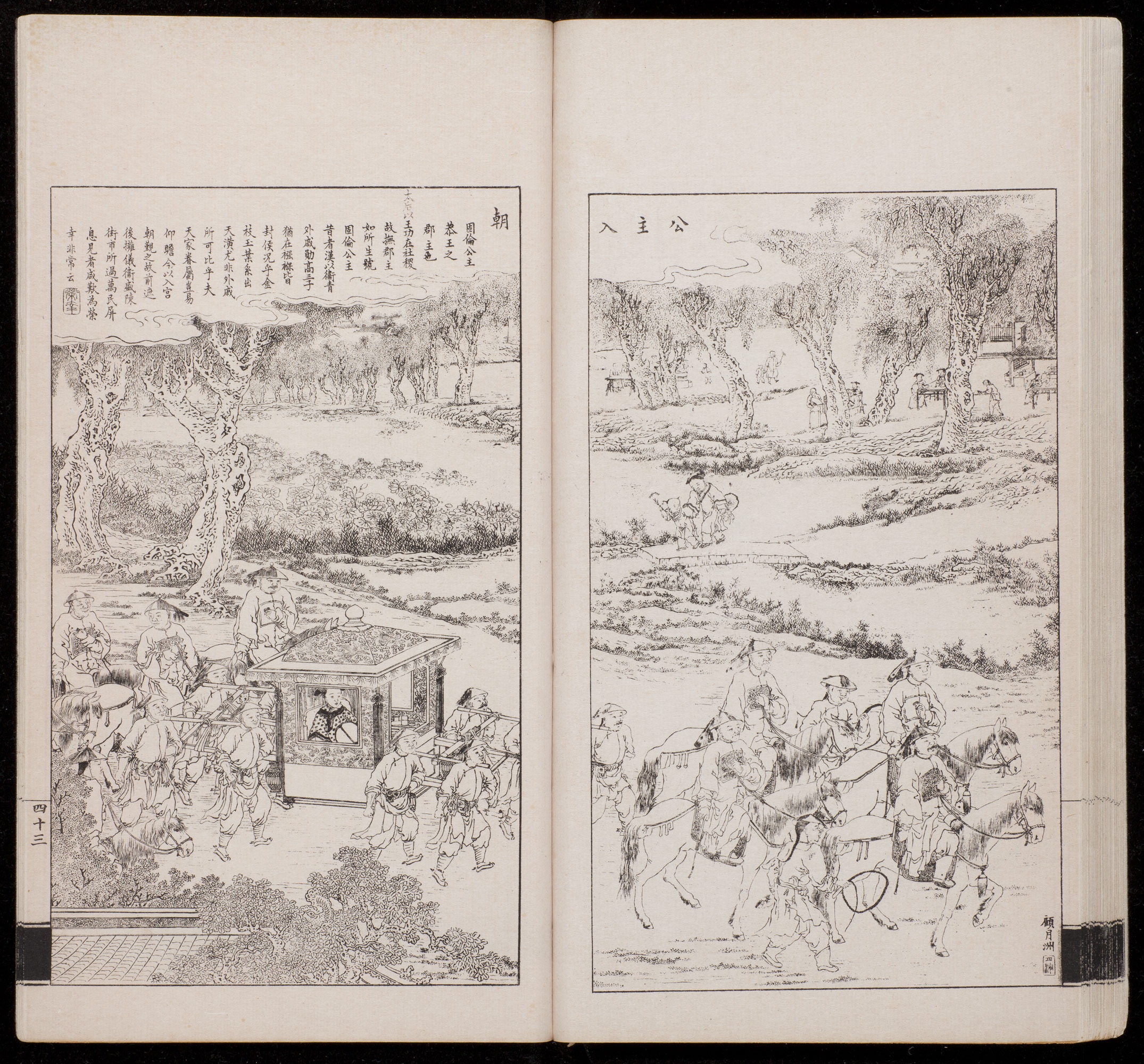 |
Title: “A Princess Enters the Imperial Court” 公主⼊入朝 Volume: 1 Issue: 6 Page Number: 43 Caption Translation: Princess Gulun is the daughter of Prince Gong. Since Prince Gong has made great contributions to the country, the Empress Dowager raised his daughter as if she were her own child, and named her Princess Gulun. In the Han Dynasty, when Wei Qing, a distant relative of the empress, performed meritorious deeds, all his three sons received fiefs while they were still in swaddling clothes. They cannot compare to Princess Gulun, who is like a gold branch and jade leaf of the royal family. Members of the imperial family are usually secluded, but now, since she is entering the Court to pay her visit to the Emperor, large crowds attended her procession, as the honor guard drew up in lines along the street. Tens of thousands of people held their breath, and all the spectators believed themselves to be extremely fortunate. |
Translator: Wang Guojun, revised by Peter C. Perdue Caption Text: 公主⼊入朝固倫公主, 恭⺩王之郡主也, 太后以⺩王功在社稷, 故撫郡主如所⽣生, 號固倫公主。 昔者 漢以衛⻘青外戚勛⾼高, 三⼦子猶在襁褓皆封侯, 況乎⾦金枝⽟玉葉, 系出天潢, 尤⾮非外戚所可⽐比乎。 夫天家眷屬, 豈易仰瞻, 今以⼊入宮朝覲之故, 前遮後擁, 儀衛盛陳, 街市所過, 萬民屏息, ⾒見者 咸歎為榮幸⾮非常云。 View on Yale Visual Resources |
 |
 |
Title: “A Model of a Virtuous Woman” 義婦可⾵風 Volume: 1 Issue: 6 Page Number: 44 Caption Translation: Hankou is a treaty port, and people from far and near come there by boat to make aliving. Among them was a boat operated by people from Huangbei county: a husbandand wife, and his younger brother. The little brother had always been an unreliable rascal. However, because he was family, the senior brother could not bear to ruin his lifeby abandoning him. So they lived in Hankou for a long time, and the senior brother spared no effort in taking care of his dear brother. One day, the senior brother lost his eyesight in an accident, and his little brother conceived a plan to kidnap his sister-in-law and sell her favors for money. Hearing ofthis, the senior brother could think of no way of saving her. He also considered that since he had lost sight in both eyes, he could not survive without his dear wife. Once they were separated he would surely die in a ditch.Desperate, he threw himself into ariver to commit suicide. Hearing this, his wife ran to him and sacrificed herself too. Onlookers seeing this virtuous act rescued both of them. Then they drove away the littlebrother and kept the whole affair secret. |
Today, even in rich and noble families, people desert their original spouses for new ones. In this case, the husband lost sight in both eyes, and only had his two hands left. Although he had hoped that they could grow old together until their hair turned white, he had to suffer nothing but days of bitter hardship. Isn't it understandable that he would try to end his life, even though his plan was stopped? Furthermore, people pressured thewife, giving her excuses to leave her husband, but even though she came from a poor family, she well understood chastity and righteousness. After such a long time inpoverty, she still attempted to die with her husband. With disheveled hair like fluttering reeds, she behaved like an upright bamboo; with a bitter heart, she arose like a lotus untainted by muddy waters. How superior she is to those loose women who enjoy abundant food and luxurious clothes!! So I hereby write down her deeds to admonish the fashionable people of our times. |
Translator: Wang Guojun, revised by Peter C. Perdue Caption Text: 漢皋為洋街⼀一都會, 駕扁⾈舟以就餬⼝口者 來遠近。 中有⼀一船, 撡之者 為⿈黃陂縣⼈人, 夫婦⼆二⼈人外, 并偕⼀一弟。 弟素無賴, 不可付以事, ⽽而兄以⼿手⾜足誼不忍棄之, 以蹙其⽣生。 故住漢雖久, 兄仍以弟撫之不稍替。 ⼀一⽇日, 兄技?来?失明, 其弟猝起诈慝, 將劫嫂作奇貨, 兄聞之, 不能為遠引計, 不能為先蕟?計, ⼜又念兩⺫⽬目已瞽, 情妻猶得相助為⽣生, ⼀一旦離披, 必⾄至就斃溝壑。 計無所出, 赴河⾃自盡, 妻聞之, 亦偕逝焉, 旁觀義之, 俱得無恙, 遂逐其弟⽽而寢其事。 嗟乎, 舍舊[?=谋?]新之舉, 今之富貴家且有然矣, ⼜又況雙眸已失, ⼗十指僅存, ⽩白頭偕⽼老之謀無⾮非茹苦含⾟辛之⽇日。 即使中途改計, 容⾮非情之所有乎。 ⼜又況有以迫之, 使得所藉⼝口乎, 尔乃雖出寒微, 偏明節義, ⾷食貧既久, 同⽳穴相要, 蓬⾸首如飛, 式彼有筠之⽵竹箭, 蓮 ⼼心⾃自苦, 不染濁⽔水之汙泥。 以視席豐履厚, 致隳名節者 , 相去何⽌止萬萬哉。 爰書其事, 以俟采⾵風者 述焉。 View on Yale Visual Resources |
 |
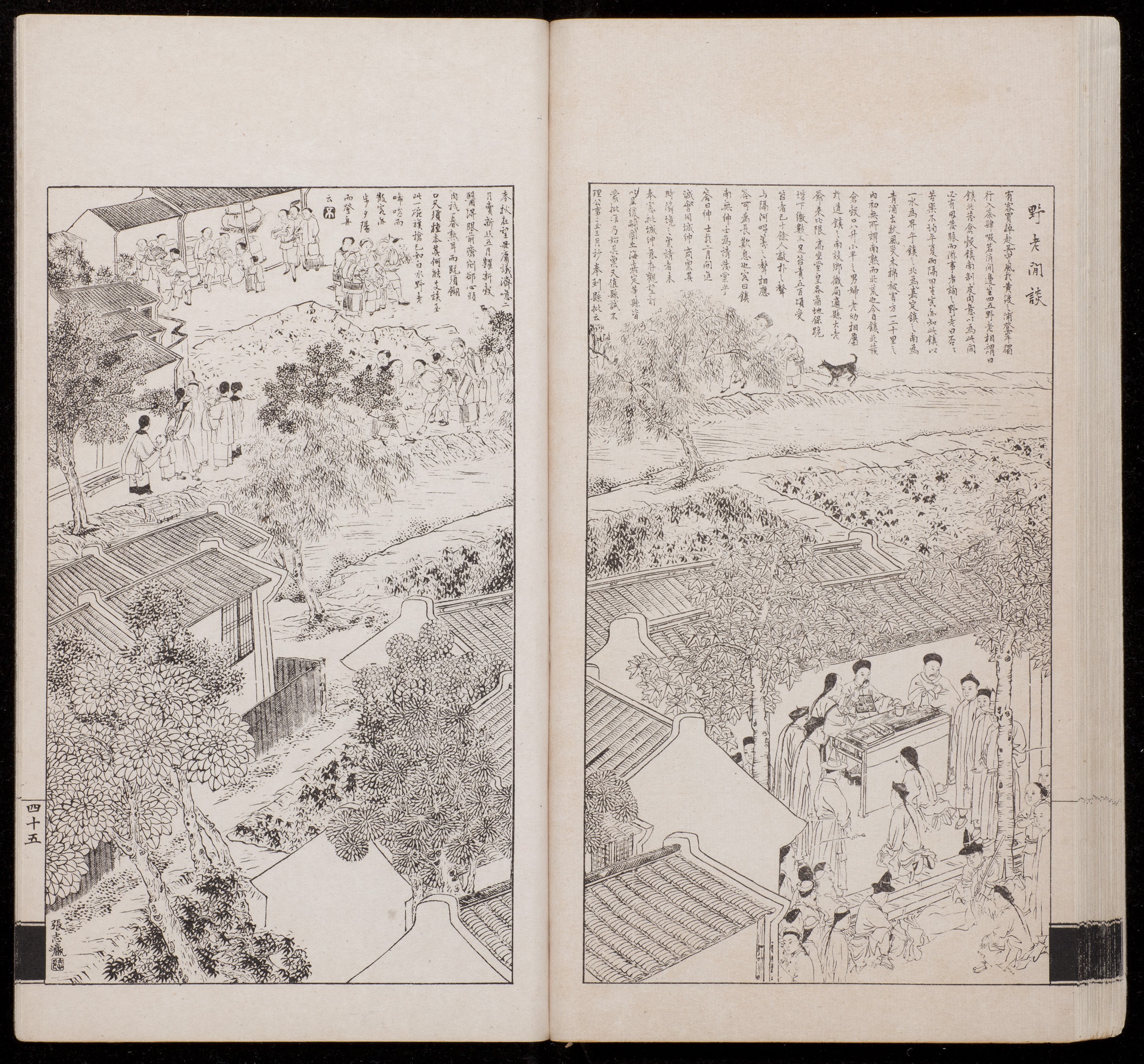 |
Title: “The Village Elders Talk of Famine” 野⽼老閒談 Volume: 1 Issue: 6 Page Number: 45 Caption Translation: A traveller was heading for Shanghai by boat. While the boat was waiting at the bank of the Huangdu river for a favorable wind, he went off walking on land by himself, and entered a tea house to while away the time. By his side sat four or five country elders,who said to each other, “In the north of this district they distribute relief from the granary, while in the south they strip off the people’s skin and flesh.” The visitor thought that they meant that the person in charge of famine relief was an outsider. When he asked theelders, they replied, “No, no. Bitterness and happiness are not distributed evenly; summer rain falls on lands selectively. Are you aware that a river divides our two districts? The northern district is Jiading, and the southern one is Qingpu. Last fall storms destroyed our rice and cotton crops. At first, within an area of ten to twenty square li, the harvest was the same, with no distinction between abundance in the southand a famine in the north. Today the northern district is distributing relief grain, eightsheng for adults and half that amount for children. So men and women, old and young all went on the road to receive it. |
The southern district, however, set up a tax-grain collection office, just when the county magistrate arrived. When taxes were due, he sat high at the official Court, with various runners kneeling down in front of the steps. Those who could not pay enough received five hundred whippings. After a while, more than ten people had been whipped. The sound of whipping accompanied the voices ofcounting relief grains across the river. What a lamentable situation!” The visitor then said, “Does not the southern district have gentlemen who could request relief?” They replied, “In February the local gentlemen went into the city to discuss the crisis with the urban elite. At that time, those in neighboring counties who requested relief had not received official approvals, so the urban elite took a wait-and-see attitude and decided to postpone their own relief petition. Only after they heard that Shanghai, Jiading and other counties all received permission did they send in a report. Further, it happened to be the time of official examination in the county, and the magistrate would conduct no official business until the third month. When the report arrived at the county, he instructed, ‘We expect a good wheat harvest in the fall, so there is no need to discuss relief.’ |
He was thinking that in February people would sell their newly woven silk, and in May they would sell new grain [to get through until thefall.] But that is like gouging out your heart to heal an urgent sore, since it means using up the entire spring harvest. People have to make a living from hand to mouth, as well as saving seeds for later sowing. How can they possibly survive?” By this time, the cup of fine tea had become as tasteless as water. The rural elders parted with sighs, and the visitor went off in the sunset and boarded his boat. Translator: Wang Guojun, revised by Peter C. Perdue |
Caption Text: 野⽼老閒談有客買棹赴吳, 守⾵風於⿈黃渡之浦, 登岸獨⾏行, ⼊入茶肆啜茗消閒。 邊坐四五野⽼老, 相謂⽈曰:鎮北發倉穀, 鎮南剝⽪皮⾁肉。 意以為此間必有因發賑⽽而遊事者 , 詢之, 野⽼老⽈曰:否, 否。 苦樂不均平, 夏⾬雨隔⽥田⽣生。 客亦知此鎮以⼀一⽔水為界乎?鎮之北為嘉定鎮, 之南為⻘青浦。 去秋⾵風災, ⽲禾棉被害, ⽅方⼀一⼆二⼗十⾥里之內, 初無所謂南熟⽽而北荒也。 今⽇日鎮北發倉穀, ⼝口⼋八升, ⼩小半之, 男婦⽼老幼相屬於道。 鎮之南設鄉徵局, 適縣⼤大⽼老爺來, ⽐比限, ⾼高坐堂皇, 各等地保跪堦下。 繳數不⾜足, 笞責五百, 頃受笞者 已⼗十餘⼈人, 敲扑之聲與隔河唱籌之聲相應答, 可為⾧長歎息也。 客⽈曰:鎮南無紳⼠士為請發棠乎? 答⽈曰:紳⼠士於⼆二⽉月間進城會同城紳商稟。 其時, 鄰境之稟請者 未奉憲批, 城紳意存觀望, 訂以且緩。 嗣聞上海嘉定等縣皆蒙批准, 乃始具稟。 ⼜又值縣試, 不理公事⾄至三⽉月, 抄奉到縣, 批云:⿆麥秋在望, ⽏毋庸議濟。 意⼆二⽉月賣新絲, 五⽉月糶新穀。 醫得眼前瘡, 剜卻⼼心頭⾁肉, 祗⼀一春熟⽿耳。 ⽽而既須餬⼝口, ⼜又須種本, 其何能⽀支诶。 ⾄至此⼀一碗旗槍, 已如⽩白⽔水。 野⽼老唏噓⽽而散, 客亦步⼣夕陽⽽而登⾈舟云。 View on Yale Visual Resources |
 |
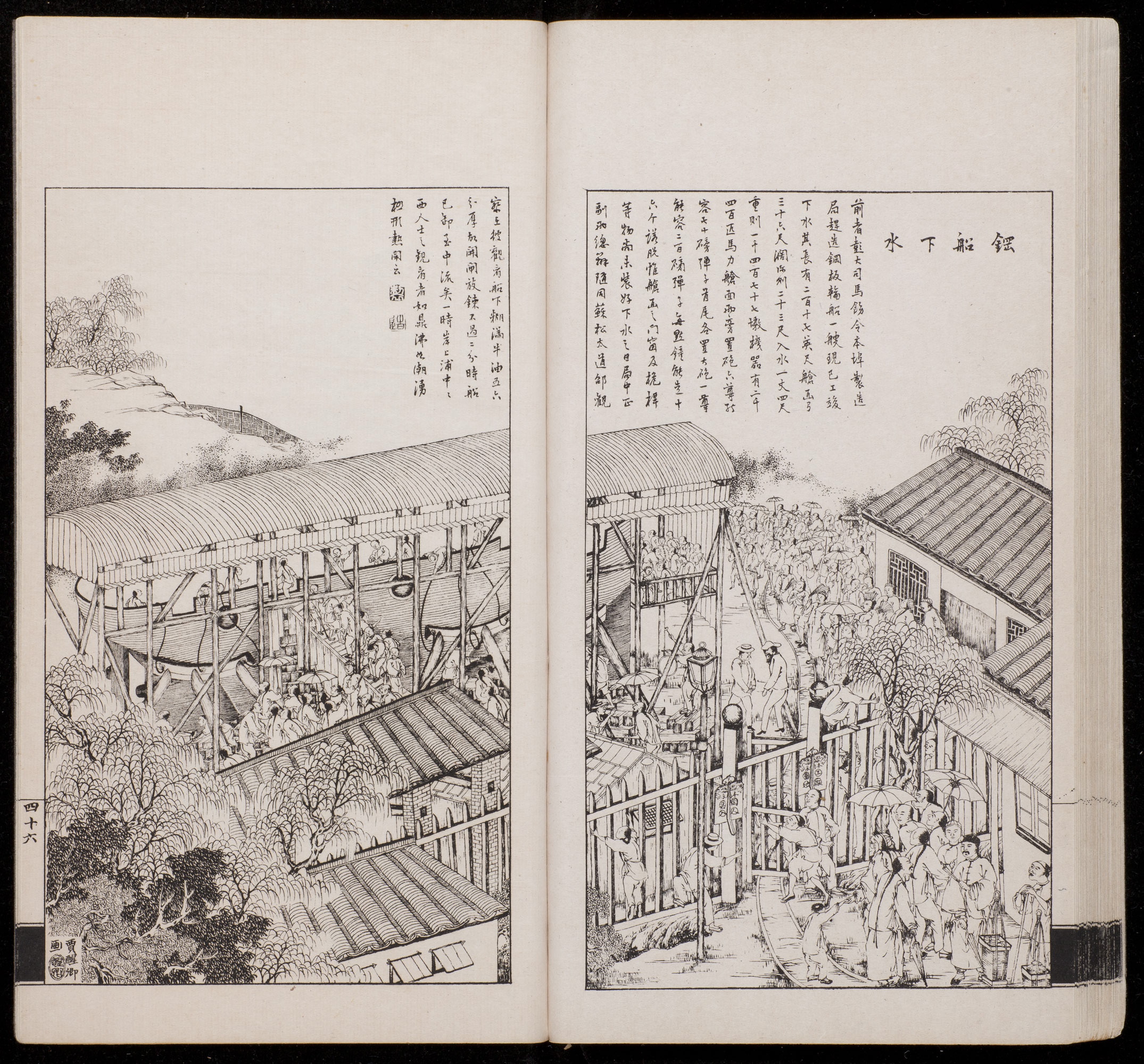 |
Title: “A Steel Ship is Launched” 鋼船下⽔水 Volume: 1 Issue: 6 Page Number: 46 Caption Translation: Previously, General Peng ordered the local arsenal to build a steel-plated steamship as quickly as possible. Now, work has already finished and the ship has been launched. It is two hundred and seven English feet in length, the deck is thirty feet long and twenty three feet wide. Fifteen feet of the ship is beneath the water, and it weighs one thousand four hundred and seventy seven [tons]. Its engines produce two thousand four hundred horsepower. On each side of the deck there are six cannons, each able to accommodate cannonballs weighing seventy pounds. Both the bow and stern are outfitted with a single large cannon able to accommodate cannonballs weighing two hundred pounds. Every hour it is able to travel sixteen [miles?]. Only the windows and doors on the deck and the mast, etc. have not yet been completely installed on the ship. The day the ship launched, two of the [officials] within the arsenal accompanied the Su-Song circuit intendant and arrived to inspect the ship. On the underside of the ship was a five or six inch thick waterproof coating of cow fat. Minutes after releasing the dock chains, the ship was already entering midstream. A tidal wave of cheers roared from the westerners watching from the bank. |
Translator: Paul Vierthaler, revised by Peter C. Perdue Caption Text: 鋼船下⽔水前者 , 彭⼤大司⾺馬飭令本埠製造局趕造鋼板輪船⼀一艘。 現已⼯工竣下⽔水。 其⾧長有⼆二百⼗十七英尺, 艙⾯面⼸弓三⼗十六尺, 闊亦列⼆二⼗十三尺, ⼊入⽔水⼀一丈四尺, 重則⼀一千四百七⼗十七墩, 機器有⼆二千四百匹⾺馬⼒力, 艙⾯面兩旁置砲六尊能容七⼗十磅彈⼦子, ⾸首尾各置⼤大砲⼀一尊能容⼆二百磅彈⼦子。 每點鐘能⾛走⼗十六個[议?脱?], 惟艙⾯面之⾨門窗及桅桿等物尚未裝好。 下⽔水之⽇日局中正副兩總[…]隨同蘇松太道邰觀察, ⾄至彼觀看船下糊滿⽜牛油五六分厚。 故閘放鍊不過⼆二分時船已卸⾄至中流矣。 ⼀一時岸上浦中之⻄西⼈人⼠士之觀看者 如⿍鼎沸如潮湧極形熱鬧云。 View on Yale Visual Resources |
 |
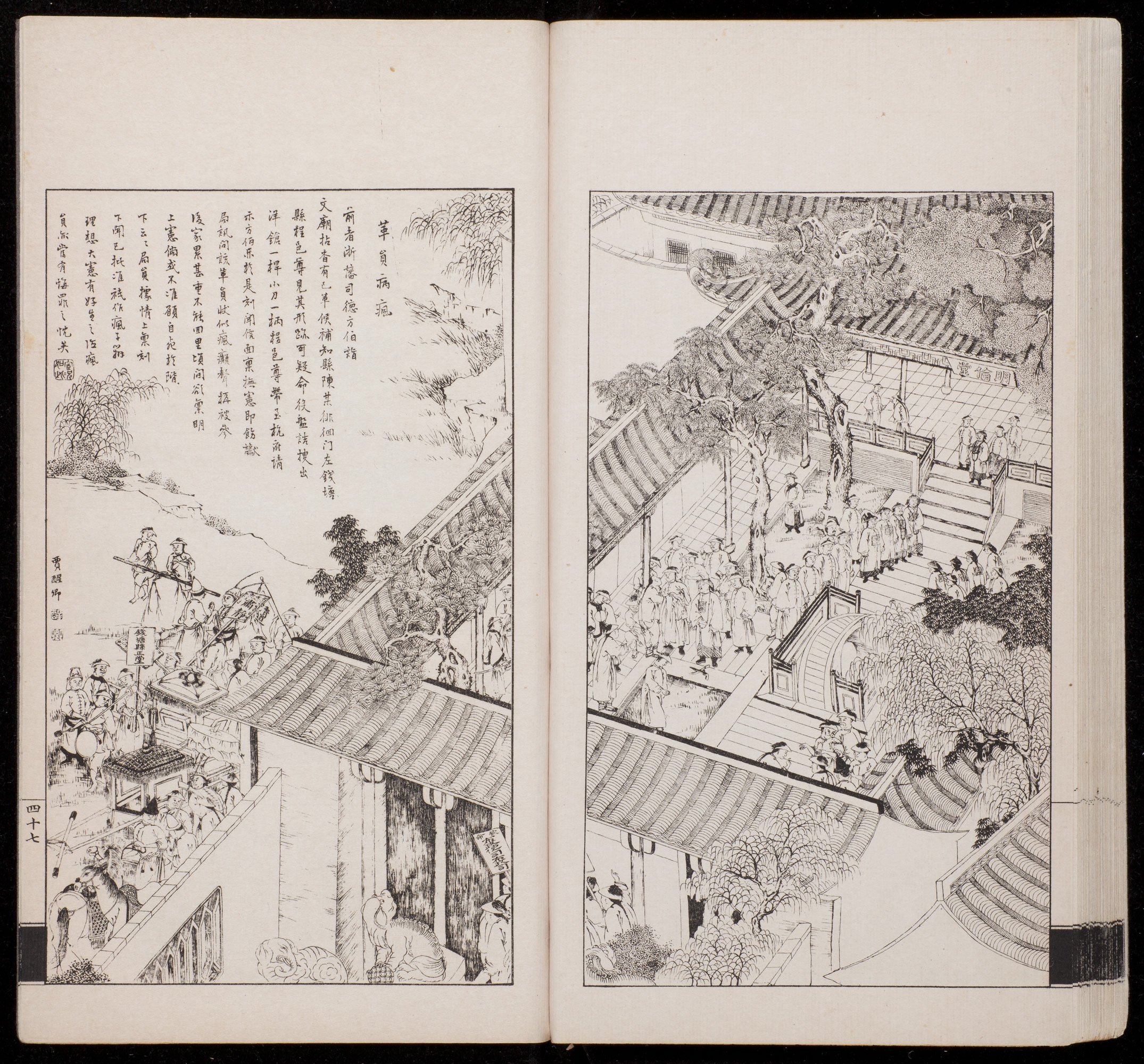 |
Title: “A Dismissed Official Goes Mad” ⾰革員病瘋 Volume: 1 Issue: 6 Page Number: 47 Caption Translation: Some time ago, the Zhejiang Regional Officer De Fangbo visited a Confucian temple to burn incense. To the left of the gate, expectant District Magistrate Chen, who had already been dismissed, was pacing back and forth. The Qiantang county city magistrate Cheng saw that he looked suspicious, and commanded him to be questioned. Upon searching him they found a foreign gun and a small knife. City magistrate Cheng took him to the Hangzhou Government offices in order to ask for instructions. As a result, the provincial official reported in person to the provincial governor and ordered the court to conduct an interrogation. This dismissed official seemed to be in an insane state of mind. After he was investigated, he professed that his family burden was very heavy, and he was unable to return to his village. Within a short while he wanted to explain his situation directly to the provincial governor. If he wasn’t allowed to do this, he was willing to kill himself upon the steps. He kept on raving in this manner. The staff accordingly reported this to their superiors. Presently, hearing that his request had already been approved, the madman's ravings ceased. We think that the Governor acted justly in preserving a person's life, but the crazy official should also sincerely show penitence for his crimes. |
Translator: Paul Vierthaler, revised by Peter C. Perdue Caption Text: ⾰革員病瘋前者 浙藩司德⽅方伯詣⽂文廟拈⾹香, 有已⾰革候補知縣陳某, 徘徊⾨門左。 錢塘縣程⾢邑尊, ⾒見其形跡可疑, 命役盤詰, 搜出洋槍⼀一桿, ⼩小⼑刀⼀一柄。 程⾢邑尊帶⾄至杭府請⽰示。 ⽅方伯亦於是刻聞信, ⾯面稟撫憲, 即飭讞局訊問。 該⾰革員狀似瘋癲, 聲稱被參後, 家累甚重, 不能回⾥里, 頃間欲稟明上憲, 倘或不准, 願⾃自斃於階下云云。 局員據情上稟, 刻下聞已批准, 祇作瘋⼦子⼀一推理。 想⼤大憲有好⽣生之德, 瘋員亦當有悔罪之忱矣。 View on Yale Visual Resources |
 |
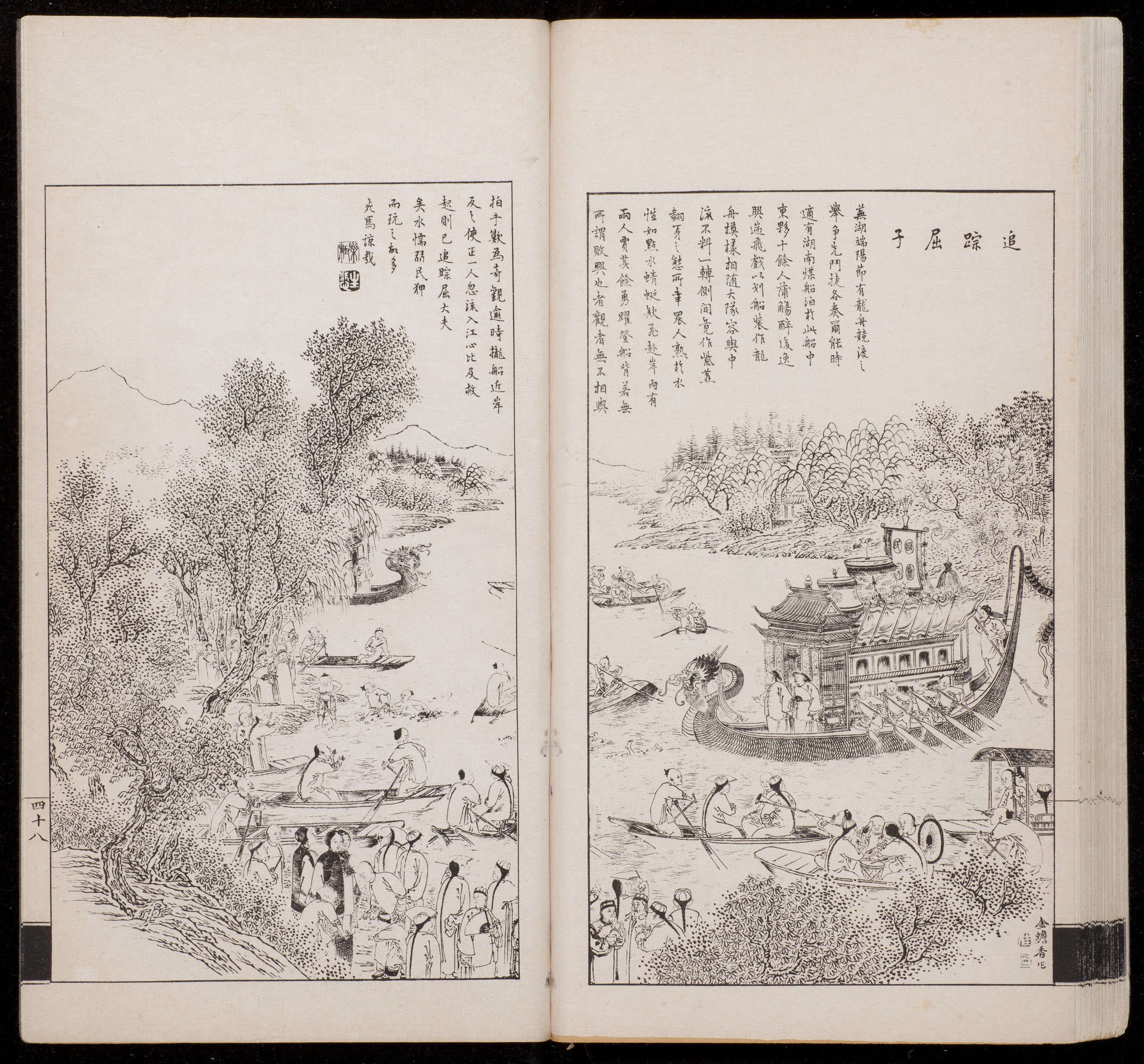 |
Title: “Following in the Footsteps of [the ancient poet] Qu Yuan” 踪屈⼦子 Volume: 1 Issue: 6 Page Number: 48 Caption Translation: Wuhu’s Duan Yang holiday includes a dragon boat race competition in which people vie to be first and win victory, and everyone demonstrates their own abilities. This time a Hunanese coal boat was anchored where the race occurred. The boss and a dozen workers celebrated with large wine cups and became extremely drunk. Carried away by their enthusiasm, they played at paddling like a dragon boat and entered the river's midstream. Unexpectedly, taking a quick turn, the boat flipped over as fast as the flight of a swallow. Fortunately, they were strong swimmers, so like water dragonflies they made their way toward the bank. Two men in the boat, showing great bravery, leapt on the bottom of the upturned boat, as if there was nothing to worry about. All the onlookers applauded this marvelous feat. Soon they pulled the boat to the bank and turned it upright. But one man, disregarding the current, jumped into the middle of the river. By the time they had pulled him out, he had already followed the example of Master Qu Yuan [i.e. he drowned]. Since water seems harmless, people don’t show it proper respect and neglect their safety. For this reason many die in it, alas! |
Translator: Paul Vierthaler, revised by Peter C. Perdue Caption Text: 追踪屈⼦子蕪湖端陽節有⻯⿓龍⾈舟競渡之舉, 爭先⾾鬥捷, 各奏爾能。 時適有湖南煤船泊於此。 船中東夥⼗十餘⼈人蒲觴醉[…], 逸興遄飛, 戲以划船裝作⻯⿓龍⾈舟模樣相隨⼤大隊, 容與中流, 不料⼀一轉側間, 竟作紫燕翻⾝身之態。 所幸眾⼈人熟於⽔水性, 如點⽔水蜻蜓款[就?]赴岸。 內有兩⼈人, 賈其餘勇躍登船背, 若無所謂敗興也者。 觀者無不相與拍⼿手歎為奇覶。 逾時攏船近岸, 反之使正, ⼀一⼈人忽流⼊入江⼼心, ⽐比及救[起]則已追踪屈⼤大夫矣。 ⽔水懦弱, 民狎⽽而玩之故多死焉, 諒哉! Comments: Duanyangjie—holiday held on 5/5 of the lunar calendar, featuring dragon-boat races, in memory of the ancient poet Qu Yuan, who drowned himself in the river as a political protest. View on Yale Visual Resources |
 |
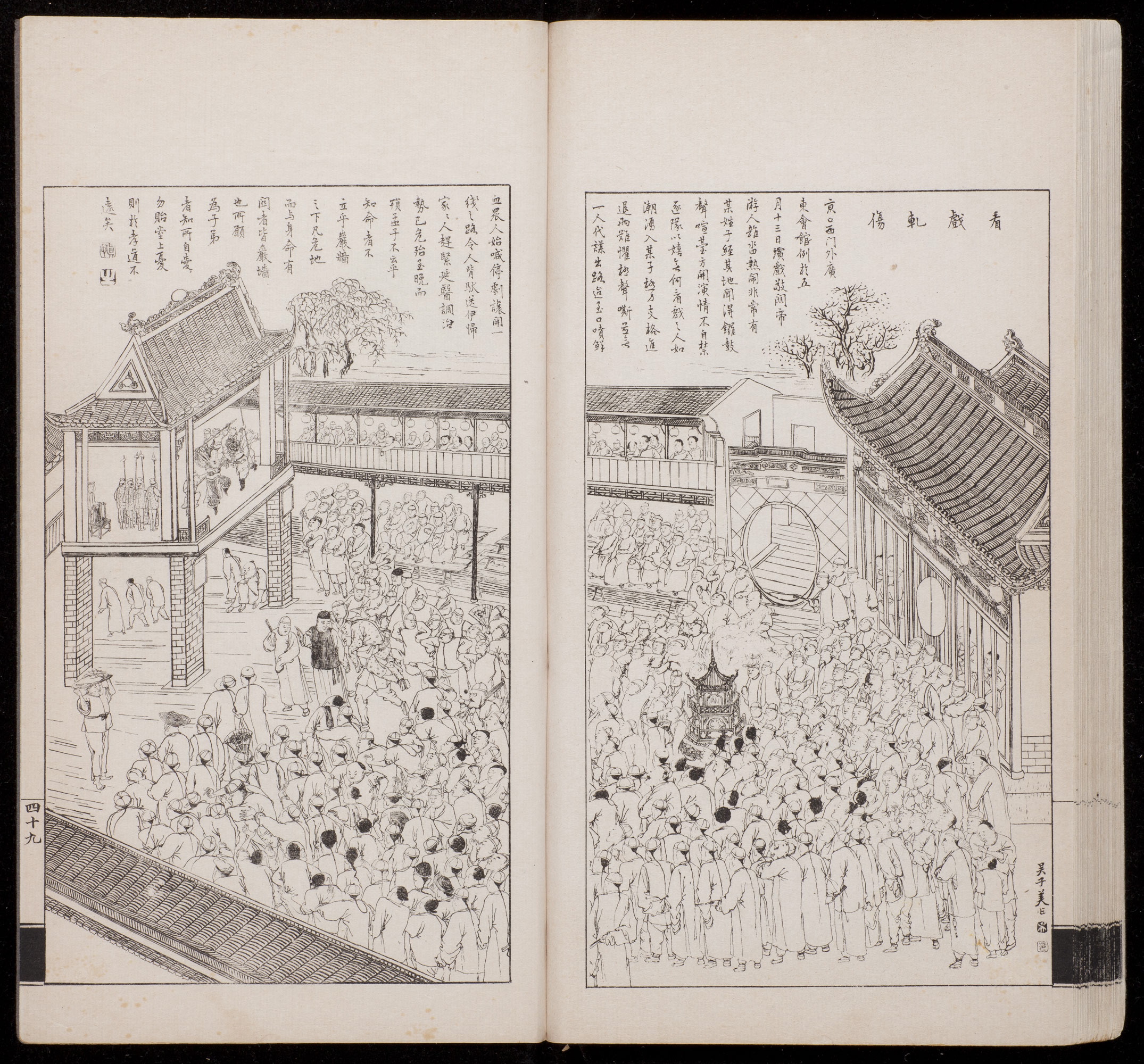 |
Title: “Crushed While Watching a Play” 看戲軋傷 Volume: 1 Issue: 6 Page Number: 49 Caption Translation: By custom, on the thirteenth day of the fifth month, the Guangdong provincial guildhall outside the west gate of the capital puts on plays to honor Guandi, the God of War. The sightseers there were disorderly and the scene was extremely lively. A young man of a distinguished family, passing by, heard the sound of drums and gongs. The play had just begun, and unable to resist the attraction, he followed the crowd to enjoy the play. Before long, a tidal wave of people pushed in, and he did his utmost to keep resisting the flow, but he got caught between a rock and a hard place. He became extremely fearful and exhausted, and he could not find a way out. When it got to the point that his mouth was spurting blood, people in the crowd began to cry out for the play to stop and to make way for him. They carried him on their backs and sent him back home. His family members hurriedly sent for a doctor to nurse him back to health, but he had lost nearly all his strength, and by the evening he died. Did not Mencius say: “those who know their destiny should not stand beneath the wall of a cliff.” He meant that all dangerous places and fateful choices are “cliff walls”! Young men, take care of yourselves! Do not cause your parents grief, and then you will not stray far from the path of filial piety. |
Translator: Paul Vierthaler, revised by Peter C. Perdue Caption Text: 看戲軋傷京⼝口⻄西⾨門外廣東會館, 例於五⽉月⼗十三⽇日演戲敬關帝。 游⼈人雜沓, 熱鬧⾮非常。 有某姓⼦子經其地, 聞得鑼⿎鼓聲喧, 臺⽅方開演, 情不⾃自禁, 逐隊以嬉。 無何, 看戲之⼈人, 如潮湧⼊入, 某⼦子極⼒力⽀支格, 進退兩難, 懼極聲嘶, 並無⼀一⼈人代謀出路。 迨⾄至⼝口噴鮮⾎血, 眾⼈人始喊停劇, 讓開⼀一綫之路, 令⼈人背馱, 送伊歸家。 家⼈人趕緊延醫調治, 勢已危, 迨⾄至晚⽽而殞。 孟⼦子不云乎:“知命者不⽴立於崕牆之下。 ”凡危地⽽而与⾝身命有關者, 皆“崕牆”也!所願為⼦子弟者, 知所⾃自愛, 勿貽堂上憂, 則於孝道不遠矣。 Comments: 莫⾮非命也,顺受其正;是故知命者不⽴立乎崖墙之下。 尽其道⽽而死者, 正命也;桎梏死者,⾮非正命也。 《孟⼦子·尽⼼心上》 Mencius said, “There is a time for everything. A man should submit to fate. Therefore, he who has the true idea of Heaven's mandate will not stand beneath a precipice. To die when your time is up is proper; to die recklessly is not man’s proper fate.” View on Yale Visual Resources |
 |
| “American Consul Arrives at Hankou” 美使抵漢 (page 42, left) 1884 [dz_v01_044] |
“White Elephant of Siam” 暹羅白象 (page 42, right) 1884 [dz_v01_044] |
“A Princess Enters the Imperial Court” 公主⼊入朝; (page 43) 1884 [dz_v01_045.jpg] |
“A Model of a Virtuous Woman” 義婦可⾵風 (page 44) 1884 [dz_v01_046.jpg] |
“The Village Elders Talk of Famine” 野⽼老閒談 (page 45) 1884 [dz_v01_047.jpg] |
“A Steel Ship is Launched”
鋼船下⽔水 (page 46) 1884 [dz_v01_048.jpg] |
“A Dismissed Official Goes Mad” ⾰革員病瘋 (page 47) 1884 [dz_v01_049.jpg] |
“Following in the Footsteps of [the ancient poet] Qu Yuan” 踪屈⼦子 (page 48) 1884 [dz_v01_050.jpg] |
“Crushed While Watching a Play” 看戲軋傷 (page 49) 1884 [dz_v01_051.jpg] |
